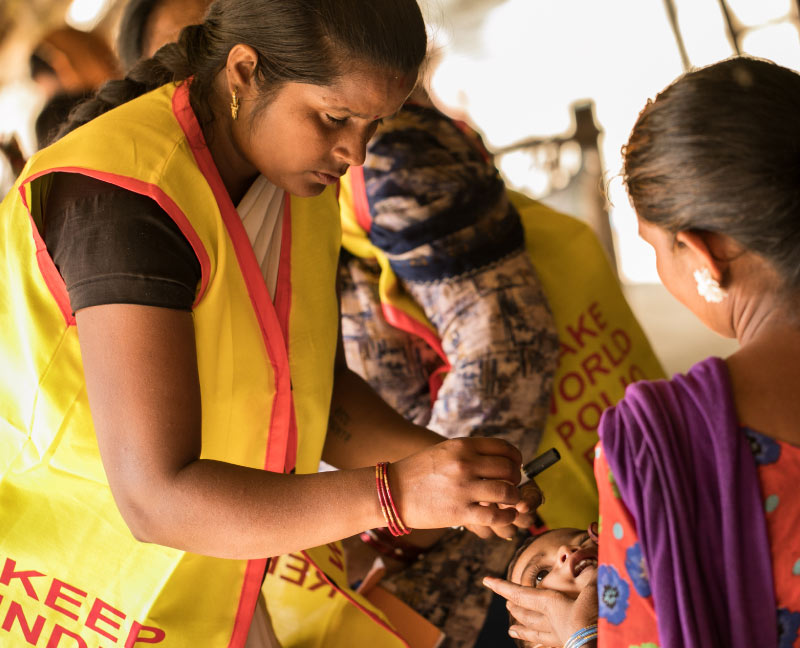
It has been over 12 years since the last case of polio was reported in India and the country was declared polio-free. But it doesn’t mean that polio cannot resurge. Every year, World Polio Day is observed on 24th October to raise awareness about this disabling disease that can cause paralysis for lifetime. We had an exclusive conversation with Mr Deepak Kapur, the Chairman of Rotary International’s India National PolioPlus Committee, who played a significant role in the polio eradication campaign in India. He, along with noted national and international health organisations, worked diligently to immunise children across the country and create awareness about the importance of polio vaccination. Their efforts resulted in a remarkable achievement in eradicating polio in India. Here are some excerpts from our conversation.
1. Tell us briefly about the Polio elimination campaign in India
Mr Kapur: India was a late entrant into the mass immunisation efforts at that time or prior to that, it was estimated that India was contributing more than 60% of the world’s cases, that is, 450 children used to get polio every day. Thanks to Rotary Sustained Advocacy, the first NID in India was organised in 1995, and it was a huge success. Our immunisation campaign steadily improved over the years despite some hiccups on the way, but today it is a model of how mass immunisation campaigns should be run.
2. Can you give us major milestones of polio’s timeline in India?
Mr Kapur: From 1995 to 2000, India made rapid progress in its quest for a polio-free India. But then, there were setbacks with mini outbreaks emerging in UP and Bihar. The world was worried and the experts thought that India would be the last nation on the Earth to get rid of polio. However, steady progress over the years proved them wrong. The last case of the polio wild virus was reported from India on 13th January 2011 and in March 2014, WHO declared India as polio-free. Since then, India is concentrating upon keeping up the immunity levels through routine immunisation and mass immunisation campaigns.
3. What are the roadblocks of polio eradication campaign in the world and how could it pose a challenge to India?
Mr Kapur: There are two kinds of roadblocks of the polio eradication campaign in the world. The first is the wild virus is still endemic in Pakistan and Afghanistan, posing a threat for the rest of the world. Secondly, vaccine-derived polio virus which is as devastating for children to get it sweeping across Africa and many other parts of the world. Both of these pose a serious risk to nations like India who are polio-free.
4. Can polio come back to India? Please explain the risks.
Mr Kapur: Polio can definitely come back to India, with the emphasis on “can.” In the past, India has exported the polio virus to every continent on Earth. And it can come back to India through the same routes of importation. Our only solution is that we have to keep our immunity levels higher than 95% of the total children up to the age of 5.
5. What is the current situation in India for polio vis-à-vis other SouthEast Asian Countries?
Mr Kapur: India is polio-free and has been free of the wild virus since the 13th of January 2011. But South Asia still has the two major reservoirs of the wild virus in the world, that exist in Pakistan and Afghanistan. Seeing the proximity of these countries to India, we need to be ultra-careful.
6. How is surveillance for poliovirus being ensured by the government and GPEI?
Mr Kapur: Surveillance in India is carried out through the National Polio Surveillance Project, a joint venture of the Government of India and WHO. We have a nationwide network for collecting AFP (Acute flaccid paralysis) samples, that is stool samples. In addition, we have world-class laboratories across the country that are carrying out regular environmental sampling. In fact, many experts in the world feel that India has the best surveillance network in the world.
7. How is it still important to overcome the stigma towards polio survivors/patients?
Mr Kapur: Sadly, polio survivors are still ostracised; families target them when there is no fault of the children. Because they’re considered to be an economic burden on the family. There have been instances where families have refused to even give a name to a child who has contracted polio. What a travesty because it was the parents who were responsible for the child getting polio by not taking the child for free immunization at the primary health centres or during mass campaigns.
8. One message for parents on World Polio Day
Mr Kapur: My message on World Polio Day would be that polio anywhere is polio everywhere. As long as the polio virus exists anywhere in the world, it poses a serious threat to all other nations. We have to keep the virus at bay, and the only way to do this would be for parents to ensure that their child is immunized through routine immunization and the primary health centres and by giving polio drops during the NIDs and SNIDs.
